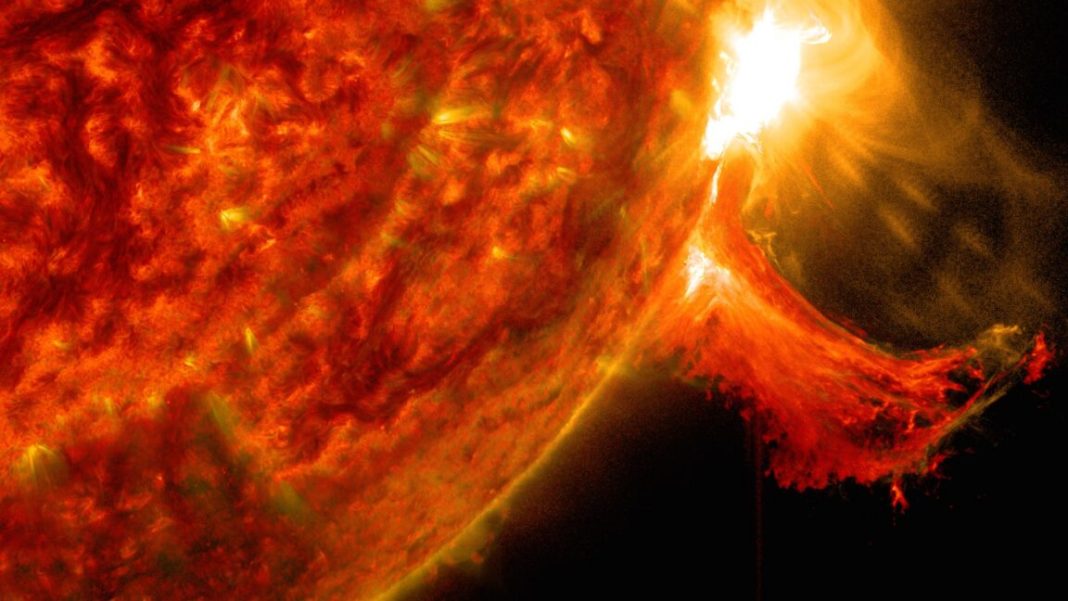Imagine the ultimate cosmic irony: an event unfathomably far away, a colossal energetic outburst some 92 million miles distant, can directly interfere with our most ambitious endeavors right here on Earth. That’s precisely what unfolded recently, putting a pause on Jeff Bezos’ much-anticipated New Glenn rocket. It wasn’t a meteor strike or a launchpad malfunction, but a celestial hiccup from our own Sun that grounded the towering Blue Origin vehicle.
For those eagerly awaiting the next giant leap in commercial spaceflight, this news might feel like a frustrating setback. Yet, it’s a fascinating testament to the interconnectedness of our solar system and the sheer power of the star that sustains us. Our quest for the stars is a delicate dance, often dictated by forces far beyond our immediate control.
A Solar Roar Heard Across the Void
The “explosion” in question wasn’t a conventional blast with a soundwave, but rather a violent expulsion of energy and matter from the Sun’s surface. Picture this: our Sun, a magnificent ball of superheated plasma, periodically unleashes titanic solar flares and coronal mass ejections (CMEs). These are essentially super-sized burps or sneezes from the star, flinging billions of tons of magnetized plasma and high-energy particles into space at incredible speeds.
When one of these cosmic tempests is directed toward Earth, it’s not an immediate impact that causes concern. Instead, it’s the subsequent interaction with our planet’s magnetic field. This creates what scientists call a geomagnetic storm – a disturbance in Earth’s magnetosphere that can have far-reaching effects. While beautiful in the form of auroras, these storms pose a serious threat to our technology, both on the ground and, crucially, in orbit.
When Cosmic Winds Ground Earthly Ambitions
So, how does a solar storm 92 million miles away ground a rocket on Earth? The connection is less about direct physical damage and more about prudence and precaution. Powerful geomagnetic storms can disrupt radio communications, interfere with GPS signals, and even induce currents in long power lines, potentially causing blackouts. For highly sensitive, multi-million-dollar space hardware like the New Glenn rocket and its payloads, the risks are manifold.
Launching a rocket during a severe space weather event is like sailing into a hurricane. The increased radiation levels can damage sensitive electronics on board, affecting anything from navigation systems to scientific instruments. Furthermore, the disturbed ionosphere can make it difficult for ground control to communicate effectively with the vehicle during critical phases of flight. Blue Origin, like all responsible space agencies and companies, adheres to strict safety protocols. When space weather forecasts indicated a significant uptick in solar activity, the decision to hold the launch was a clear, albeit frustrating, necessity. Safety, especially when launching humans or incredibly valuable satellites, always comes first.
The Unseen Threads of Space Weather
This grounding serves as a potent reminder of the ever-present, yet often unseen, forces at play in our solar system. As humanity becomes increasingly reliant on space infrastructure – from communication satellites to navigation systems and weather monitoring – our vulnerability to solar activity grows. Predicting space weather with precision is a complex and ongoing challenge, requiring a network of solar observatories and sophisticated modeling techniques.
“It’s a stark reminder,” mused Dr. Anya Sharma, a prominent heliophysics expert, “that even as we reach for the stars, our home star dictates the rhythm of our journey. Space isn’t just a vacuum; it’s a dynamic, occasionally violent ocean we navigate, and understanding its currents is paramount to safe passage.” This incident underscores the importance of continued research into solar physics and the development of more resilient space technology.
Ultimately, the temporary grounding of New Glenn isn’t a failure, but a calculated pause. It’s a testament to the meticulous planning and safety-first approach required for space exploration. While we eagerly await New Glenn’s rescheduled debut, this event quietly highlights the incredible power of our Sun and the intricate balance we must strike as we venture further into its domain.




